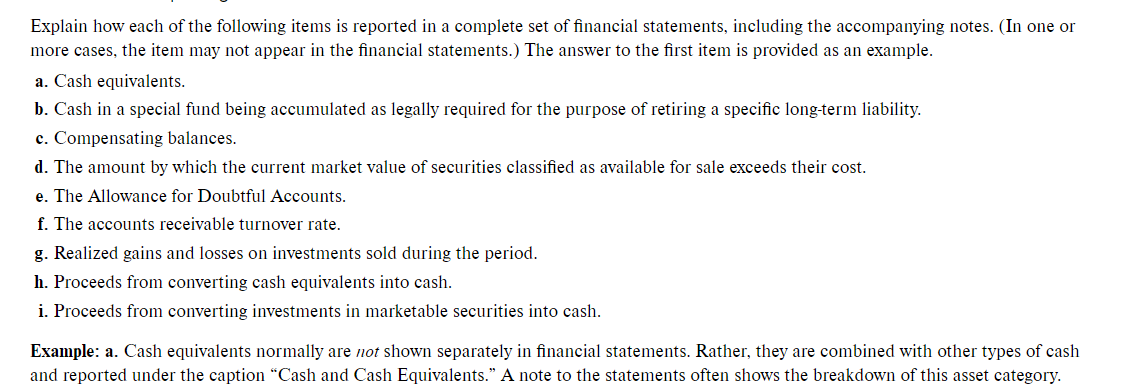Explain how each of the following items is reported in a complete set of financial statements, including the accompanying notes. (In one or more cases, the item may not appear in the financial statements.) The answer to the first item is provided as an example. a. Cash equivalents. b. Cash in a special fund being accumulated as legally required for the purpose of retiring a specific long-term liability. c. Compensating balances. d. The amount by which the current market value of securities classified as available for sale exceeds their cost. e. The Allowance for Doubtful Accounts. f. The accounts receivable turnover rate. g. Realized gains and losses on investments sold during the period. h. Proceeds from converting cash equivalents into cash. i. Proceeds from converting investments in marketable securities into cash. Example: a. Cash equivalents normally are not shown separately in financial statements. Rather, they are combined with other types of cash and reported under the caption “Cash and Cash Equivalents." A note to the statements often shows the breakdown of this asset category.
Reporting Cash Flows
Reporting of cash flows means a statement of cash flow which is a financial statement. A cash flow statement is prepared by gathering all the data regarding inflows and outflows of a company. The cash flow statement includes cash inflows and outflows from various activities such as operating, financing, and investment. Reporting this statement is important because it is the main financial statement of the company.
Balance Sheet
A balance sheet is an integral part of the set of financial statements of an organization that reports the assets, liabilities, equity (shareholding) capital, other short and long-term debts, along with other related items. A balance sheet is one of the most critical measures of the financial performance and position of the company, and as the name suggests, the statement must balance the assets against the liabilities and equity. The assets are what the company owns, and the liabilities represent what the company owes. Equity represents the amount invested in the business, either by the promoters of the company or by external shareholders. The total assets must match total liabilities plus equity.
Financial Statements
Financial statements are written records of an organization which provide a true and real picture of business activities. It shows the financial position and the operating performance of the company. It is prepared at the end of every financial cycle. It includes three main components that are balance sheet, income statement and cash flow statement.
Owner's Capital
Before we begin to understand what Owner’s capital is and what Equity financing is to an organization, it is important to understand some basic accounting terminologies. A double-entry bookkeeping system Normal account balances are those which are expected to have either a debit balance or a credit balance, depending on the nature of the account. An asset account will have a debit balance as normal balance because an asset is a debit account. Similarly, a liability account will have the normal balance as a credit balance because it is amount owed, representing a credit account. Equity is also said to have a credit balance as its normal balance. However, sometimes the normal balances may be reversed, often due to incorrect journal or posting entries or other accounting/ clerical errors.

Trending now
This is a popular solution!
Step by step
Solved in 2 steps









